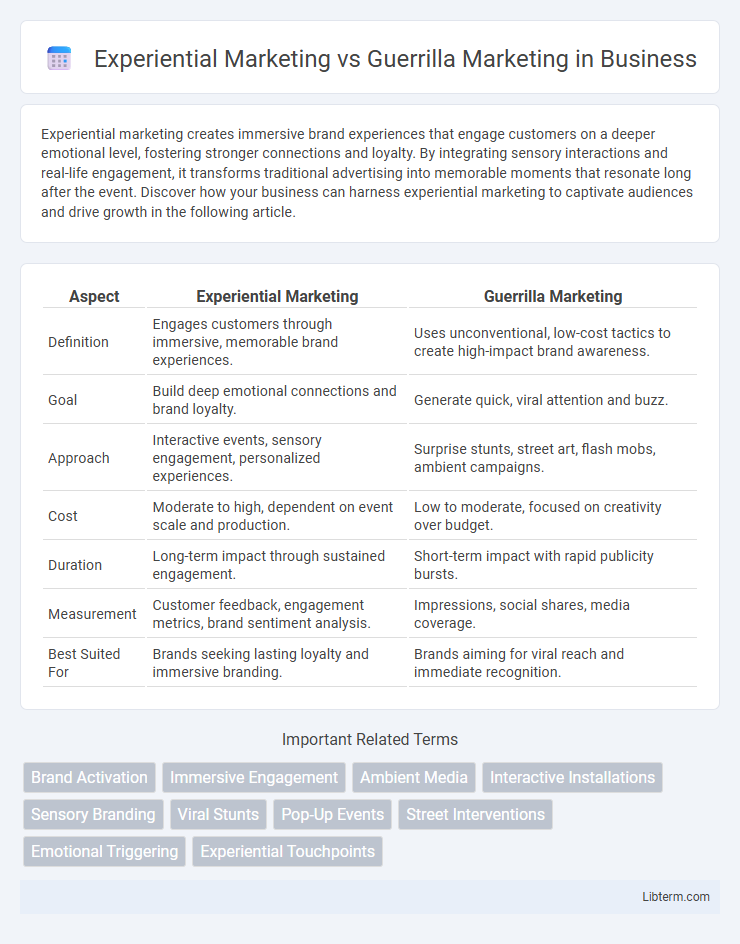Experiential marketing creates immersive brand experiences that engage customers on a deeper emotional level, fostering stronger connections and loyalty. By integrating sensory interactions and real-life engagement, it transforms traditional advertising into memorable moments that resonate long after the event. Discover how your business can harness experiential marketing to captivate audiences and drive growth in the following article.
Table of Comparison
| Aspect | Experiential Marketing | Guerrilla Marketing |
|---|---|---|
| Definition | Engages customers through immersive, memorable brand experiences. | Uses unconventional, low-cost tactics to create high-impact brand awareness. |
| Goal | Build deep emotional connections and brand loyalty. | Generate quick, viral attention and buzz. |
| Approach | Interactive events, sensory engagement, personalized experiences. | Surprise stunts, street art, flash mobs, ambient campaigns. |
| Cost | Moderate to high, dependent on event scale and production. | Low to moderate, focused on creativity over budget. |
| Duration | Long-term impact through sustained engagement. | Short-term impact with rapid publicity bursts. |
| Measurement | Customer feedback, engagement metrics, brand sentiment analysis. | Impressions, social shares, media coverage. |
| Best Suited For | Brands seeking lasting loyalty and immersive branding. | Brands aiming for viral reach and immediate recognition. |
Understanding Experiential Marketing
Experiential marketing creates immersive brand experiences that engage consumers through interactive events, fostering emotional connections and memorable interactions. It leverages sensory stimulation and direct participation to build brand loyalty and encourage word-of-mouth promotion. This strategy contrasts with guerrilla marketing's unconventional, low-cost tactics by prioritizing meaningful, personalized consumer engagement.
Defining Guerrilla Marketing
Guerrilla marketing is an unconventional marketing strategy focused on low-cost, high-impact tactics designed to create memorable experiences and generate buzz. It relies on creativity and surprise elements to engage the audience in unexpected places, often leveraging public spaces and viral potential. Unlike experiential marketing, which emphasizes immersive brand interactions, guerrilla marketing centers on disruptive campaigns that maximize exposure with minimal budget.
Core Objectives: Engagement vs. Disruption
Experiential marketing aims to create meaningful customer interactions by immersing audiences in brand-driven experiences that foster emotional connections and long-term loyalty. Guerrilla marketing focuses on creating disruptive, unconventional campaigns that capture immediate attention and generate buzz through surprise and novelty. While experiential marketing prioritizes deep engagement and memorable brand experiences, guerrilla marketing leverages shock value to quickly stand out in crowded marketplaces.
Key Strategies in Experiential Marketing
Experiential marketing centers on creating immersive, interactive brand experiences that engage consumers emotionally and physically, using tactics like live events, product demonstrations, and sensory activations to forge memorable connections. Key strategies emphasize personalization, storytelling, and direct consumer participation to drive brand loyalty and advocacy. This approach leverages data-driven insights and technology to tailor campaigns, ensuring meaningful, impactful interactions that extend beyond traditional advertising.
Guerrilla Marketing Tactics Explained
Guerrilla marketing tactics rely on unconventional, low-cost strategies designed to create maximum impact through surprise and creativity, often leveraging public spaces and viral potential. Techniques include ambush marketing, street art, flash mobs, and stunt-based campaigns that engage audiences directly while fostering word-of-mouth promotion. Brands use guerrilla marketing to disrupt traditional advertising channels, generate buzz, and build strong emotional connections with target consumers.
Target Audience and Reach
Experiential marketing targets highly engaged audiences by creating immersive brand experiences that foster emotional connections and long-term loyalty. Guerrilla marketing aims at broad or niche audiences through unconventional, low-cost tactics designed to generate immediate buzz and viral reach. Both strategies prioritize audience impact, but experiential marketing focuses on depth of engagement while guerrilla marketing emphasizes wide visibility and shareability.
Budget Considerations and ROI
Experiential marketing often requires a higher budget due to the need for immersive, multi-sensory brand engagements that create lasting consumer memories. Guerrilla marketing focuses on low-cost, unconventional tactics aimed at generating buzz and viral potential with minimal financial investment. ROI in experiential marketing typically stems from deeper customer connections and brand loyalty, while guerrilla marketing relies on rapid brand exposure and cost-effective audience reach.
Notable Success Stories
Experiential marketing achieved remarkable success with brands like Red Bull's Stratos Jump, where Felix Baumgartner's space dive created global excitement and deep consumer engagement. Guerrilla marketing demonstrated its power through campaigns such as the Blair Witch Project, which used low-budget viral tactics to generate massive buzz and box office success. Both strategies thrive on creativity and emotional connection, driving memorable brand experiences that significantly boost visibility and consumer loyalty.
Common Challenges and Pitfalls
Experiential marketing and guerrilla marketing both face challenges in maintaining audience engagement without overwhelming or alienating consumers, often requiring precise targeting and creative messaging to be effective. Budget constraints and measuring return on investment pose significant pitfalls, as experiential campaigns can be resource-intensive and guerrilla tactics may generate unpredictable results. Ensuring legal compliance and managing public perception are critical, given the unconventional nature of guerrilla marketing and the immersive settings of experiential marketing.
Choosing the Right Approach for Your Brand
Selecting the right approach between experiential marketing and guerrilla marketing depends on your brand's goals, target audience, and budget. Experiential marketing excels at creating immersive, memorable brand engagements that build deep emotional connections, while guerrilla marketing leverages unconventional, low-cost tactics to generate buzz and viral impact quickly. Evaluate your brand's identity and campaign objectives to determine whether a high-impact, interactive experience or a surprising, attention-grabbing stunt will best drive customer engagement and brand awareness.
Experiential Marketing Infographic

 libterm.com
libterm.com